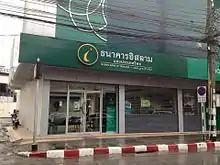 | |
 A branch of Islamic Bank in Bangkok (2020) | |
Native name | ธนาคารอิสลามแห่งประเทศไทย |
|---|---|
| Type | State enterprise |
| Industry | Islamic banking |
| Founded | 21 October 2002 |
| Headquarters | Watthana, Bangkok 10110[1] , Thailand |
Number of locations | 108 |
Area served | Thailand |
Key people | Monchai Rattanasatien, Acting Managing Director[2] |
| -9.5 billion baht[3]: 5 | |
| Total assets | 109.7 billion baht[3]: 3 |
| Parent | Ministry of Finance |
| Website | Official website |

The Islamic Bank of Thailand (iBank) (Thai: ธนาคารอิสลามแห่งประเทศไทย, RTGS: Thanakhan Itsalam Haeng Prathet Thai) was established in 2002.[4]
The bank is 48.54 percent owned by the Thai Ministry of Finance, 39.81 percent by the Government Savings Bank, and 9.83 percent by Krung Thai Bank. The Ministry of Finance's direct shareholding in iBank is capped at 49 percent, but shareholdings by other state-owned banks mean that the government controls over 98 percent of iBank shares.[5][6]
iBank's Swift code is TIBTTHBK.[7] The bank's fiscal year runs from 1 January to 31 December. iBank operates in accordance with the principles of Islamic Sharia law as practiced in Islamic banking and finance. It serves all customers regardless of religious affiliation.[4]
History
The Islamic Bank is a state-owned enterprise and has 130 branches throughout the country (2015). It is set up under the Islamic Bank of Thailand Act 2002. It began operations in 2003. By the end of 2005 the bank had total of nine branches. The bank acquired the Shariah Banking Services of Krung Thai Bank PCL in November 2005. As a result, the number of branches increased from 18 to 27.[4]
Performance
For the year ending 2014, iBank reported total assets of 109.7 billion baht.[3]: 3 Net profit for the year was -9.5 billion baht.[3]: 5
Bailout
The management competence of state-run financial institutions such as the Islamic Bank has been called into question by critics who point to the Finance Ministry's injection of almost 20 billion baht into iBank to raise its registered capital. The intervention was required because iBank had accrued 50 billion baht in non-performing loans (NPL), half of all its loan portfolio.[8][9]
References
- ↑ "Islamic Bank of Thailand". Bangkok Post. Retrieved 31 December 2015.
- ↑ "Ministry of Finance's Top Executives". Ministry of Finance (Thailand). Retrieved 31 December 2015.
- 1 2 3 4 "Auditor report and Financial Statements 2014". Islamic Bank of Thailand. Archived from the original on 21 August 2016. Retrieved 31 December 2015.
- 1 2 3 "History". Islamic Bank of Thailand. Archived from the original on 19 August 2018. Retrieved 31 December 2015.
- ↑ "Shareholders List". Islamic Bank of Thailand. Archived from the original on 13 January 2019. Retrieved 31 December 2015.
- ↑ "Fitch Affirms Ratings on Six Policy Banks in Thailand". Fitch Ratings Thailand. 1 December 2014. Archived from the original on 20 September 2016.
- ↑ "การรับเงินโอนเข้าจากต่างประเทศ". Islamic Bank of Thailand. Archived from the original on 13 January 2019. Retrieved 31 December 2015.
- ↑ Theparat, Chatrudee (31 May 2018). "Finance Ministry to hold 99% of IBank". Bangkok Post. Retrieved 25 July 2019.
- ↑ Chantanusornsiri, Wichit (25 July 2019). "Good governance sorely lacking at state-run banks" (Opinion). Bangkok Post. Retrieved 25 July 2019.